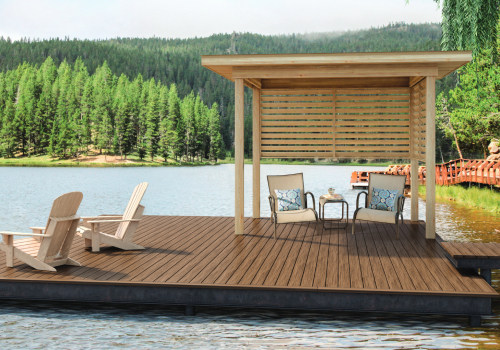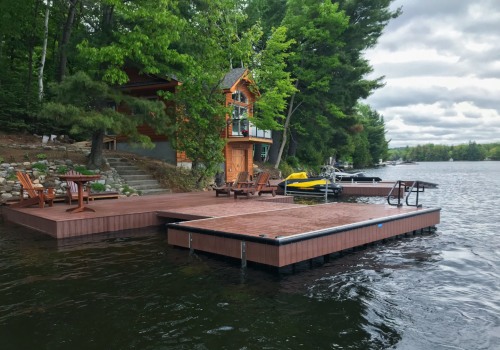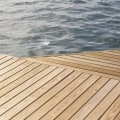Welcome to our comprehensive guide on cable anchoring for floating docks! If you're looking for information on how to properly secure your dock, you've come to the right place. Whether you're a boat owner, marina manager, or just interested in dock design, understanding the ins and outs of cable anchoring is crucial for ensuring the safety and stability of your floating dock. In this article, we will dive into the world of cable anchoring, discussing its importance, best practices, and different techniques. So, let's get started and explore everything you need to know about cable anchoring for floating docks in detail. Cable anchoring is an essential aspect of floating dock design and construction.
It involves securing the dock in place using cables attached to the bottom of the water body. This method is crucial for ensuring that your dock stays in place despite strong currents, winds, and other external factors. Without proper cable anchoring, your floating dock may drift away or become unstable, posing a safety hazard for you and your watercraft. Now, let's take a closer look at the different aspects of cable anchoring. The first and most important aspect is the type of cable used.
It is recommended to use high-quality, marine-grade steel cables for anchoring floating docks. These cables are specifically designed to withstand harsh underwater conditions and provide maximum strength and durability. The length and thickness of the cables also play a significant role in the effectiveness of cable anchoring. It is crucial to determine the appropriate length and thickness based on the size and weight of your floating dock, as well as the depth and type of water body it will be anchored in. Another crucial aspect to consider is the anchoring system itself. There are various types of anchoring systems available, such as pile anchors, deadweight anchors, and helical anchors.
The type of system you choose will depend on factors such as water depth, soil composition, and budget. Proper installation of the anchoring system is also vital for its effectiveness. It is recommended to hire a professional dock builder or contractor who has experience in installing cable anchors for floating docks. They will ensure that the anchors are placed at the correct angle and depth for maximum stability. In addition to securing your floating dock in place, cable anchoring also helps distribute weight evenly, reducing stress on specific points of the dock. This can help prolong the lifespan of your dock and prevent costly repairs or replacements. In conclusion, cable anchoring is a crucial aspect of floating dock design and construction.
It not only ensures the safety and stability of your dock but also helps prolong its lifespan. When properly installed and maintained, cable anchoring can provide peace of mind for dock owners and users, knowing that their dock is securely anchored in place. So if you are in the process of building a floating dock or looking to improve the stability of your existing one, be sure to consider cable anchoring as an essential component of your design.
Construction: What You Need to Know
To build a sturdy and reliable floating dock, proper cable anchoring is essential. In this section, we will discuss the various considerations and steps involved in constructing a dock with cable anchoring.Installation: Tips and Tricks
Once your dock is built, the next step is installation.This may seem like a daunting task, but with the right knowledge and techniques, it can be done effectively. We will guide you through the installation process and provide tips on how to ensure your cables are properly anchored.
Design Ideas and Services for Floating Docks
Aside from functionality, floating docks can also be visually appealing. In this section, we will showcase some Design Ideas and services related to floating docks, including cable anchoring options that can enhance the overall look of your dock.Maintenance and Repair: Keeping Your Dock in Top Shape
Like any structure, floating docks require regular maintenance to ensure their longevity. When it comes to cable anchoring, there are a few key steps you can take to keep your dock in top shape.1.Inspect the Cables Regularly
The first step in maintaining your dock's cable anchoring is to regularly inspect the cables for any signs of wear and tear.This can include fraying, rust, or corrosion. It's important to catch these issues early on before they become bigger problems.
2.Clean the Cables
Saltwater and other environmental factors can cause buildup on your dock's cables, which can lead to corrosion. To prevent this, make sure to clean the cables regularly with a mild soap and water solution. You can also use a wire brush or sandpaper to remove any stubborn buildup.3.Tighten Loose Cables
If you notice any loose cables during your inspections, it's important to tighten them as soon as possible.Loose cables can compromise the stability of your dock and make it more susceptible to damage.
4.Replace Damaged Cables
In some cases, you may need to replace damaged cables altogether. This is especially important if the damage is severe or if the cable is at risk of breaking. It's always better to be safe than sorry when it comes to the safety of your dock and watercraft.5.Consider Professional Maintenance
If you are unsure about how to properly maintain your dock's cable anchoring or if you notice any significant issues, it's always a good idea to consult a professional. They will have the expertise and tools needed to ensure your dock is in top shape. By following these steps, you can keep your dock's cable anchoring in excellent condition and extend its lifespan.However, even with proper maintenance, damages can still occur. In the next section, we will cover how to identify and repair any damages to your dock's cable anchoring.
Cost and Materials: What You Need to Know Before Building a Dock
Before embarking on a dock building project, it is important to have an idea of the cost and materials involved. This will help you budget effectively and avoid any unexpected expenses. When it comes to cable anchoring for floating docks, the costs can vary depending on several factors. The main expense for cable anchoring is the materials needed.These include the cable itself, anchors, and hardware such as turnbuckles and shackles. The type and quality of these materials will greatly impact the overall cost. For example, stainless steel hardware will be more expensive than galvanized steel, but it will also be more durable and resistant to corrosion. Another factor to consider is the length and number of cables needed. This will depend on the size and shape of your floating dock, as well as the water conditions where it will be located.
Generally, the larger the dock and the rougher the water, the more cables will be needed for proper anchoring. Aside from the materials, labor costs should also be taken into account. Depending on your experience and expertise, you may choose to install the cable anchoring yourself or hire a professional dock builder. Keep in mind that hiring a professional may increase the overall cost, but it can also ensure that the anchoring is done correctly and effectively. Now that we have covered the costs involved in cable anchoring for floating docks, let's talk about ways to save money without sacrificing quality. One way is to shop around and compare prices for materials.
Look for deals and discounts, and consider purchasing in bulk to save on costs. You can also opt for slightly cheaper materials that still meet safety standards. For example, instead of using stainless steel hardware, you can choose galvanized steel which is still strong and durable. Lastly, consider the long-term costs when making decisions about materials. Spending a little more on higher quality materials now can save you money in the long run by avoiding frequent replacements or repairs. In conclusion, cable anchoring is a crucial aspect of building and maintaining a floating dock. By following the steps and tips outlined in this guide, you can ensure a sturdy and durable dock that can withstand various external factors.
Remember to regularly inspect and maintain your cables for optimal performance. We hope this article has been informative and helpful in your dock building journey.






